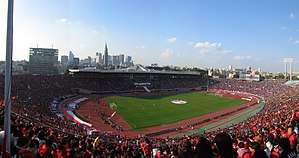National Stadium (Tokyo, 1958)
National Stadium (国立競技場, Kokuritsu kyōgijō) was a multi-purpose stadium in Kasumigaoka, Shinjuku, Tokyo, Japan. The stadium served as the main stadium for the opening and closing ceremonies, as well as being the venue for track and field events at the 1964 Summer Olympics. The Japan national football team's home matches and major football club cup finals were held at the stadium. The stadium's official capacity was 57,363, but the seating capacity was only 48,000 seats.
Kokuritsu Kyōgijō | |
 The stadium during a J.League Cup match, 2004 | |
| Location | 10-2, Kasumigaoka-machi, Shinjuku, Tokyo, Japan |
|---|---|
| Public transit | |
| Owner | Japan Sport Council |
| Capacity | 48,000 |
| Field size | 105 m × 68 m (344 ft × 223 ft) |
| Surface | Grass |
| Construction | |
| Opened | March 1958 |
| Closed | 2014 |
| Demolished | 2015 |
| Architect | Mitsuo Katayama |
Demolition was completed in May 2015, and the site will be redeveloped with a new larger-capacity National Olympic Stadium.[1] The new stadium is set to be the main venue for the 2020 Summer Olympics and Paralympics.
The original plans for the new stadium were scrapped in July 2015 by Japanese prime minister Shinzo Abe, who announced a rebid after a public outcry because of increased building costs. As a result, the new design was not ready for the 2019 Rugby World Cup, as originally intended.[2] A new design created by architect Kengo Kuma was chosen in December 2015 to replace the original design and was completed in November 2019.
History
The stadium was completed in 1958 as the Japanese National Stadium on the site of the former Meiji Shrine Outer Park Stadium. Its first major event was the 1958 Asian Games.
The venue was unscathed by the 2011 Tōhoku earthquake and tsunami. Yasuhiro Nakamori, international relations director for the Japanese Olympic Committee, told Around the Rings he attributed the lack of damage to Japan's stringent building codes.[3]
The National Stadium has also held a few number of music concerts in the past: The Three Tenors (Luciano Pavarotti, Plácido Domingo, and Jose Carreras) in 1996, SMAP in 2005, Dreams Come True in 2007, Arashi (15 concerts between 2008 and 2013),[4] L'Arc-en-Ciel in 2012,[5] Momoiro Clover Z in 2014,[6] AKB48 in 2014,[7] and finally, the Joint concert "Sayonara National Stadium Final Week Japan Night" in May 28 & 29, 2014,[8][9] which served as final goodbye to the stadium before being demolished, with artists such as Ikimono-gakari, Gospellers, Sukima Switch, Naoto Inti Raymi, Funky Kato, Sekai no Owari, Perfume, Man with a Mission, L'Arc-en-Ciel, among others.
Notable Events
- 1958: Asian Games
- 1964: Summer Olympics
- 1967: Summer Universiade
- 1976–1979: Japan Bowl
- 1979: FIFA World Youth Championship
- 1981–2001: Intercontinental Cup
- 1991: World Championships in Athletics
- 1993: J.League Opening Match (Verdy Kawasaki vs Yokohama Marinos)
- 1993: FIFA U-17 World Championship
- 1996: The Three Tenors Concert
- 2002: PRIDE Shockwave 2002
- 2003: Japan Top League Opening Match
- 2005–2008: FIFA Club World Cup
- 2009: AFC Champions League Final
- 2010: AFC Champions League Final
Transportation
Access to the stadium was from Sendagaya or Shinanomachi stations along the JR Chūō-Sōbu Line; from Kokuritsu Kyogijo Station on the Toei Oedo Line; and from Gaienmae Station on the Tokyo Metro Ginza Line.
References
- "Demolition of Tokyo's old Olympic stadium completed, clearing way for new 2020 Olympic venue". espn.go.com. ESPN. 2015-05-13. Retrieved 2015-09-26.
- Himmer, Alastair (17 July 2015). "Japan rips up 2020 Olympic stadium plans to start anew". news.yahoo.com. AFP. Retrieved 17 July 2015.
- "Tokyo Olympic Venues Escape Earthquake Damage". Aroundtherings.com. 2011-03-11. Retrieved 2015-09-26.
- "Archived copy". Archived from the original on 2012-07-21. Retrieved 2019-05-19.CS1 maint: archived copy as title (link)
- "L'Arc~en~Ciel LIVE 2014 - National Stadium, March 21st, 2014 (Fri) - March 22nd, 2014 (Sat)". larcenciel.livejournal.com.
- "Live Report: Momoclo's DREAMED Kokuritsu!!". Japanese kawaii idol music culture news | Tokyo Girls Update.
- "AKB来年3・29国立単独公演 女性グループでは初― スポニチ Sponichi Annex 芸能". Sponichi.co.jp. 2013-12-18. Retrieved 2020-03-29.
- "Archived copy". Archived from the original on 2014-05-27. Retrieved 2019-05-19.CS1 maint: archived copy as title (link)
- "SAYONARA National Stadium FINAL WEEK JAPAN NIGHT – Day 2 [29th May 2014] | Kojacon Report".
Sources
- 1964 Summer Olympics official report. Volume 1. Part 1. pp. 118–20.
External links
| Wikimedia Commons has media related to National Olympic Stadium (Tokyo). |
- Official website(in Japanese)
- Satellite photo of the stadium from Google Maps
- Stadiums in Japan:Tokyo National Stadium
- National Stadium
- National Stadium, Tokyo
| Preceded by Stadio Olimpico Rome |
Summer Olympics Opening and Closing Ceremonies (National Stadium) 1964 |
Succeeded by Estadio Olímpico Universitario Mexico City |
| Preceded by Stadio Olimpico Rome |
Olympic Athletics competitions Main Venue 1964 |
Succeeded by Estadio Olímpico Universitario Mexico City |
| Preceded by Stadio Flaminio Rome |
Summer Olympics Football Men's Finals (National Stadium) 1964 |
Succeeded by Estadio Azteca Mexico City |
| Preceded by Two-legged finals |
Intercontinental Cup Final Venue 1980–2001 |
Succeeded by International Stadium Yokohama Yokohama |
| Preceded by Vacant ( Two-legged finals ) |
AFC Champions League Final Venue 2009, 2010 |
Succeeded by Jeonju World Cup Stadium |
| Preceded by Bielefelder Alm Bielefeld |
FIFA U-20 Women's World Cup Final Venue 2012 |
Succeeded by Olympic Stadium Montreal |


